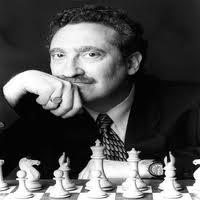
Pandolfini's Puzzler #33 - Knights to Remember
Professor: Class, how special it is to see you.
Zephyr & Lucian: Hello, Professor. We do feel pretty special.
Professor: Don’t let it go to your heads, but I’d like to start off with a question, if you don’t mind.
Zephyr: I don’t mind at all.
Lucian: I don’t mind either.
Professor: Good! Then let me ask it. In an ending of king and pawn vs. king and knight, would you rather have the pawn or the knight?

Lucian: Everyone knows a knight is generally worth more than a pawn.
Zephyr: Well not everyone. I can think of a few people who aren’t sure about it.
Lucian: Ha ha.
Zephyr: Anyhow, in the described situation, the knight offers insufficient mating material.
Lucian: Though the pawn could still queen. Maybe the pawn is better.
Zephyr: Unless, of course, the king and pawn are very badly placed.
Professor: I know exactly what Zephyr means, and I think our first example, as incredibly simple as it is, shows what she’s alluding to.
Question 1: How can White force mate?
Lucian: I see your point. White mates in two moves.
Zephyr: True. It’s like I’ve said. It’s because the black forces are so poorly positioned. They’re cornered, so to speak.
Professor: Yes, that’s the idea.
Lucian: But Professor, what happens if it’s Black’s turn to start?
Zephyr: I see what you’re getting at. Knights have trouble gaining or losing tempi by themselves.
----

Lucian: They tend to do things in twos, don’t they?
Zephyr: The always go from light to dark to light.
Lucian: That means that some of these positions may not be winnable.
Professor: I love the way the two of you conduct your own class.
Zephyr: Let’s see. If it’s Black’s turn to start, Black has to play 1…Ka2.
Lucian: That does change things. Now Nc1, giving check, doesn’t do it.
Professor: How true. Still, White from there does have a forced mate, not in two moves, but now in three moves.
Question 2: How can White force mate in three moves?
It didn’t take an eternity. In fact, it took only three moves. And the two skilled students figured it out in less than a minute.
Zephyr: That mate was a little different, but it was fairly straightforward.
Lucian: Conceptually, it wasn’t harder than the first mate at all.
Zephyr: Usually, Professor, you give us problems a little harder than that.
Lucian: Yeah, why not give us a similar mate that takes longer, just to make it a little harder?

Professor: Why? Does the length of a problem necessarily decide its degree of difficulty?
Zephyr: No, not automatically.
Lucian: Even so, don’t you have a four-move mate in your bag of tricks?
Professor: I can’t remember the last time someone described my briefcase as a bag of tricks.
Lucian: You mean, it’s not a bag of tricks?

Zephyr: Actually, it looks more like an attaché, a beat-up one at that.
Lucian: How about that mate in four that seems to be floating in the air?
Professor: No, I prefer to bring you back to Earth. With your feet on the ground, please take a peek at the next diagram, which offers a mate in five.
Question 3: How can White force mate in five moves?
This problem proved to be a twinge harder than expected, so the analysts took longer. But not that long. After five minutes or so they had found the correct answer and checked to make sure.
Professor: Very good work. I like the fancy pirouette your knight did.
Lucian: Shucks, Professor. It wasn’t anything.
Professor: Well, it was something. It took you five minutes. Something like a minute a move.
Zephyr: You don’t happen to have another problem?
Lucian: Do you, Professor?
Professor: It turns out that I do.
Zephyr & Lucian: We can’t wait to see it!
Question 4: How can White force mate in six moves?
And so the professor’s protégés began to analyze, and after a mere five minutes (well, maybe six minutes), they had the solution. Now it’s your turn. Answer all four questions and give correct variations to solving the puzzles. Once again, may Caissa guide you!
Answer below - Try to solve ProfessorPando's Puzzle first!
ANSWER #33
For question 1, the answer is 1. Nc1 a2 (Black is forced to ensnare his own king) 2. Nb3 mate.
For question 2, the answer is 1. Nb4+ Ka1 2. Kc1 a2 3. Nc2 mate.
(Problem 2 was composed by O. Dehler and it was published in "Deustche Schachzeitung" in 1924.)
For question 3, the answer is 1. Nf5 Ka1 2. Nd4 Ka2 3. Ne2 Ka1 4. Nc1 a2 5. Nb3 mate.
(Problem 3 was composed by C. H. Courtney and it was published in the "New York Clipper" in 1864.)
For question 4, the answer is 1. Nc2+ Ka2 2. Nd4 Ka1 3. Kc2 (gaining an important tempo, so that the pawn can’t safely move) 3…Ka2 4. Ne2 Ka1 5. Nc1 a2 6. Nb3 mate.
(Problem 4 was composed by Carl Jaenisch in 1837.)
Take note
In the above circumstances, the mates were possible because Black’s king was cornered. Much of it depended on timing. If the knight begins too far away from the action, it can’t get close enough in time to deliver mate before Black advances the pawn to self stalemate, saving the game.
RELATED STUDY MATERIAL
- Watch PlayfulSquirrel explain more ideas of how to use a knight in the endgame;
- What happens if the knight faces a rook pawn without the king's help? StrongHeart's got you covered;
- Sometimes you need to "self-stalemate" to save the game, and BoundingOwl shows you how!






